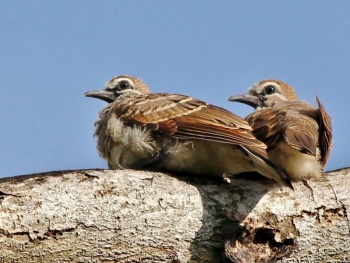Alternative name: Peaceful Dove (from before species split; see Taxonomy, below)
- Geopelia striata
Identification
Length 20·5–21·5 cm (8-8½ in), weight 40-60 g
Adult:
- A small dove with long, narrow tail
- Brownish-grey upperparts with black-and-white barring
- Pinkish underparts
- Black bars on the sides of the neck, breast and belly
- Blue-grey face
- Bare blue skin around the eyes
- White tipped tail feathers
Juvenile:
- Duller and paler than the adults
Similar Species
Peaceful Dove differs in having less strongly barred flanks, while conversely, Barred Dove has more barring on the flanks and belly; both also have different songs.
Distribution

Photo © by Rosnan_yahya
Johore, Malaysia, 21 December 2005
Native to southeast Asia in southernmost Myanmar, southern Thailand, Malaysia, Sumatra and Java.
Widely introduced in the tropics, including Hawaii, where it is abundant, the Philippines, Borneo, Tahiti, Sulawesi, the Moluccas, Saint Helena, Madagascar, the Seychelles, and Thailand to the north of its native areas. Also very popular in captivity, so escapes may appear almost anywhere worldwide.
Taxonomy
This is a monotypic species[1][2]. It was formerly considered conspecific with Peaceful Dove and Barred Dove, being split on the basis of substantial vocal differences as well as more subtle plumage differences[2].
Habitat
Mangroves, forests, hotel grounds, bush, parks; rural and urban areas.
Behaviour
Diet
Their diet consists of a wide variety of grain, weed and grass seeds; supplemented with insects.
Breeding
The males display to the female by bowing the head and spreading the tail. The platform nest is formed from leaves and grass and usually found in a bush or tree. The 1 or 2 white eggs are incubated by both adults for 13-18 days; the young fledging after 2 weeks.
Vocalisation
Call:a soft, staccato cooing.
References
- Clements, J. F., T. S. Schulenberg, M. J. Iliff, S. M. Billerman, T. A. Fredericks, B. L. Sullivan, and C. L. Wood. 2019. The eBird/Clements Checklist of Birds of the World: v2019. Downloaded from http://www.birds.cornell.edu/clementschecklist/download/
- Del Hoyo, J, A Elliot, and J Sargatal, eds. 1997. Handbook of the Birds of the World. Volume 4: Sandgrouse to Cuckoos. Barcelona: Lynx Edicions. ISBN 978-8487334221
- Baptista, L.F., Trail, P.W., Horblit, H.M. & Kirwan, G.M. (2020). Zebra Dove (Geopelia striata). In: del Hoyo, J., Elliott, A., Sargatal, J., Christie, D.A. & de Juana, E. (eds.). Handbook of the Birds of the World Alive. Lynx Edicions, Barcelona. (retrieved from https://www.hbw.com/node/54200 on 24 January 2020).
- Gibbs D, Barnes E, Cox J (2010) Pigeons and Doves: A Guide to the Pigeons and Doves of the World. Christopher Helm, London.
- Goodwin, D. (1983) Pigeons and Doves of the World. Cornell Univ. Press.
- Pyle, R.L., and P. Pyle. 2017. The Birds of the Hawaiian Islands: Occurrence, History, Distribution, and Status. B.P. Bishop Museum, Honolulu, HI, U.S.A. Version 2 (1 January 2017) http://hbs.bishopmuseum.org/birds/rlp-monograph/
- Wikipedia contributors. (2020, January 1). Zebra dove. In Wikipedia, The Free Encyclopedia. Retrieved 09:51, January 24, 2020, from https://en.wikipedia.org/w/index.php?title=Zebra_dove&oldid=933565564
Recommended Citation
- BirdForum Opus contributors. (2025) Zebra Dove. In: BirdForum, the forum for wild birds and birding. Retrieved 17 May 2025 from https://www.birdforum.net/opus/Zebra_Dove
External Links
GSearch checked for 2020 platform.1





